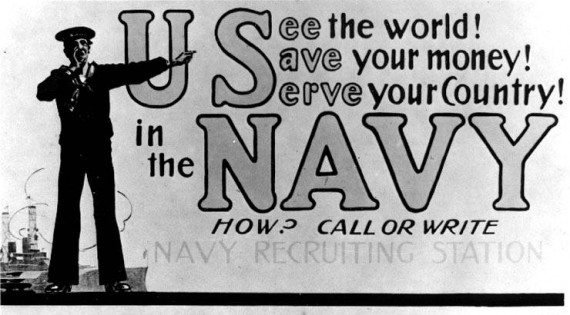Navy Refuses to Track Money, Just Because
The Defense Department would like to get a handle on how it spends its money by 2017 but the Navy won't go along.
The Defense Department would like to get a handle on how it spends its money by 2017 but the Navy won’t go along.
Norfolk Virginian-Pilot (“When oversight lacks oversight“):
In an effort to provide some consistency and ensure that precious pennies are spent wisely, each of the military branches is due to improve oversight to modern accounting standards by 2017, according to a report by the Center for Public Integrity.
Part of the Navy’s effort involved the installation of a system to “keep track of its finances and resources, including inventories, readiness, vessels, aircraft, and spare parts” and produce reports that can be audited. The system cost about $870 million, according to a report from the Pentagon Inspector General, and was supposed to replace a multitude of older systems.
Here’s the problem, according to the IG’s findings: The Navy isn’t using that expensive computer system. About $416 billion in military equipment assets – 85 percent of the total – aren’t being tracked by the new “enterprise resource planning” tool.
Why not? Because the Navy hasn’t changed its ways, according to the IG: “… Office of Financial Operations officials did not reengineer the business process to record military equipment assets in the Navy ERP system and did not use the asset management functionality for military equipment asset management in the Navy ERP system.”
The Pentagon IG says that the Navy’s reluctance to change how it tracks money means that it might not be able to meet the 2017 deadline set by law, only the latest in a series of deadlines the military has missed.
More immediately, the Navy’s slow-walking means that it doesn’t have an adequate way of measuring something’s cradle-to-grave costs. Which means that it can’t know how much money it needs with any precision.
That’s perhaps no surprise.
“Navy officials have not clearly stated why they did not change their process for tracking equipment before rolling out the new, $870 million accounting system,” CPI reported. “In their response to the IG, Navy financial management staffers said they could not provide documentation of the decision. The report said that as of January 2013, no plan was in place to take action.”
The July 18 IG report, titled “Navy Did Not Develop Processes in the Navy Enterprise Resource Planning System to Account for Military Equipment Assets,” is rather tepid, simply issuing recommendations and requiring that the Assistant Secretary of the Navy (Financial Management and Comptroller) and Navy Chief Management Officer answer some questions by August 19. They even say “please.”
It should be noted that the Navy here is thumbing its nose at Congress.
Public Law 111-84, “National Defense Authorization Act of 2010,” October 28, 2009, requires auditable DoD financial statements by September 30, 2017.
You’d think that seven years would be adequate to comply with a directive to start doing something they should have been doing all along. But, apparently, their previous system simply didn’t allow them to track everything.
The Assistant Secretary of the Navy (Financial Management and Comptroller) acknowledged seven material weaknesses1 related to seven of the Navy’s business processes and systems (Collections and Disbursements, Procure to Pay Processes, Real Property, General Equipment, Military Equipment, Operating Materials and Supplies, and Inventory) that prevent the Navy from producing auditable financial statements. These material weaknesses exist, in part, because the Navy did not design its legacy accounting systems to maintain auditable data at the transaction level to support the amounts reported on its financial statements. As of September 30, 2012, the Navy reported a military equipmentasset balance of $416 billion, which represents 85 percent of total asset sreported in the Defense Departmental Reporting System-Audited Financial Statements (DDRS-AFS).
So, we can readily see why the Navy would be reluctant to transition from using such an awesome system.
We identified an internal control weakness regarding the implementation of the Navy ERP system. Specifically, FMO personnel did not use the Navy ERP system to support $416 billion in military equipment assets. This occurred because FMO officials did not reengineer the business process to record military equipment assets in the Navy ERP system and did not use the asset management functionality for military equipment in the Navy ERP system.
Even by DoD standards, $416 billion is a lot of money. And it gets better:
As a result, Navy officials spent $870 million to implement the Navy ERP system and still did not correct the preexisting military equipment material weakness.
But it’s a big system, right? It’s going to take some time to get buy-in and switch over.
Navy officials first identified military equipment valuation as a long-standing financial material weakness in 2005. In addition, the DoD Office of Inspector General and the Government Accountability Office noted inaccurate reporting of military equipment on Navy’s financial statements as early as 1996. Given this, Navy officials identified the Navy ERP system as the solution to its military equipment material weakness.
1996 wasn’t that long ago, right?
Navy officials stated in the December 2005 plan, before the first system implementation in 2007, that it would use the Navy ERP system to account for military equipment assets. In the November 2012 plan, the military equipment material weakness was still linked to the Navy ERP system. In addition, several Navy ERP requirements documents (such as the Navy ERP Economic Analysis for Full Deployment Decision, March 23, 2011, and Navy’s Capability Production Document for Navy ERP, version 3, June 30, 2009) outlined how the Navy ERP system would automate and track the recording of military equipment assets. However, FMO personnel stated that the Navy ERP system did not account for military equipment assets because they did not plan to account for military equipment assets using the system.
Pray tell, why not?
FMO officials did not reengineer the business processes to record military equipment assets in the Navy ERP system and did not configure the functionality for military
equipment asset management in the Navy ERP system. We made several attempts to determine why the business processes for military equipment asset reporting was not
reengineered before the Navy ERP’s implementation. In response, FMO personnel stated they could not provide documentation for this decision and any response would be part of their official response to the draft report. In addition, FMO personnel confirmed that, as of January 2013, no plan was in place to include military equipment asset management in the Navy ERP system.
So, there’s no plan because there’s no plan? Except for, well, the plans.
The IG provides a handy flowchart of the existing process:
The IG submits that the process “is inefficient and the Navy cannot trace the military equipment summary value back to individual military equipment assets, resulting in an inadequate audit trail.” They suggest an alternative process: “Navy personnel could enter military equipment assets directly into the Navy ERP system, when acquired, and all accounting functions related to those assets could occur in the Navy ERP system. The military equipment assets information could then be sent, through direct interface, to the DDRSBudgetary and ultimately to the DDRS-AFS for financial reporting. ” Here’s how this ”hypothetical” (i.e., what the law requires) process would look:
It’s a shame there’s not some entity or entities above the Navy to more strongly suggest they implement this hypothetical process or otherwise figure out how to account for billions of dollars of assets.







Nearly a decade ago in the early days of my blog I wrote a post on the FBI’s botched plans for updating its fragmented and outmoded information environment. Presumably, the Navy has all of the problems the FBI did times ten.
There are problems with the federal government’s entire development and procurement strategies in information technology. Some of the problems are tied to budgetary and budget management constraints, others to organizational limits. Not the least of the problems are related to security as the whole Snowden snafu should have revealed.
@Dave Schuler: Unless things have changed radically since I was at DISA 8 years ago, DoD uses the same procurement system for everything from battle tanks to software. It makes zero sense, everybody knows it, but they still do it.
While working on a consulting projects, I worked with implementing consultants for EPR systems. They kept repeating that organizations should change their business processes to match their EPR software rather than trying to configure the software to match the current business process.
It seems that the Navy split the difference that did not either configure the software or change their business process. Of course, it does not help that senior management’s careers are based on the current business process and will be gone before any process can be implemented. The situation also shows a failure of senior management to plan for the future.
Superdestroyer — winner winner chicken dinner. This failure is likely a direct product of the senior leadership’s reluctance to adapt because their career successes are predicated on understanding and manipulating legacy systems. This just wouldn’t do in the corporate world, I suspect. So this is kind of a big deal, with lots of money at stake. So who gets fired over this?
Since when has the Military Industrial Complex given a fig what is suggested by any entities not themselves (let alone any supposedly ‘above’ them)? What are these entities going to do? Re-direct that funding to infrastructure? HILARIOUS!
@Scott F.: Well, they could start by radically slashing the budget and firing senior leaders who are supposed to be, well, leading.
@Butch Bracknell:
The corporate world wouldn’t stand for manipulating data to enrich its officers? Excuse me? Have you been in a coma for the last couple of decades?
Threaten to slash their budget, then they will get serious.
Steve
@michael reynolds: Not since, Sarbanes-Oxley, no. At least not in this particular regard. Sarbanes-Oxley parses the corporate veil by require the CEO and CFO to sign their financial statements and provides for individual liability for those officers. Of course, this only applies to SEC registrants.
@James Joyner: This would be the same Congress that forces unwanted additions to funding onto Defense to keep pet projects running?
@Gromitt Gunn:
I think I would characterize those provisions of Sarb-Ox as “untested”. There have been astonishingly few prosecutions of CEOs and CFOs for false financial statement certification crimes. The SEC has talked about 200 or so civil suits but nobody seems to be able to name more than a very few under the false financial statement certification provisions.
Even in the case of financial institutions in which virtually nobody doubts that there was false certification of financial statements there have been no cases brought under those provisions.
@superdestroyer: @Butch Bracknell: This does happen in the corporate world. I was a manufacturing engineer for a large multinational contract manufacturer and on the team to introduce and implement a new ERP system. The first problem was that upper management chose a system that really didn’t fit our business model but it could have been made to work. The biggest problem we ran into was not upper management but the purchasing department. They had been doing things the same way for decades and wouldn’t or perhaps couldn’t change. The solution to this problem turned out to be getting a new purchasing department. The next problem did involve upper management. The ERP system could easily be used for capacity planning or the bidding process but not both. Upper management did not understand this and I eventually was laid off after a few heated discussions. The bidding process was a good one and did not require the ERP system but it was ideally suited for capacity planning. Yes the government has problems but because of transparency we hear about them. THe corporate world has the same problems but we don’t hear about them but they both cost us money.
@Butch Bracknell:
Are you kidding me??!! This happens every day in the corporate world.
The fact is that — channeling JKB for a moment — this sort of thing is a hallmark of bureaucratic structures which optimize their processes for their legacy infrastructure. The only people interested in change are those far to the bottom — who have no political power — and some at the top — who have no actual implementation power if middle management resists.
And how does this differ from what I see is a more atrocious accounting issue posted here under a month ago? Pentagon’s Broken Payroll System Having used the Navy’s system 11 years ago, it gets looney, particularly trying to assign life-cycle costs – and the same occurs in business.
Aircraft carriers:
0 Training – was 1 recently, got to keep that category open
Nimitz Class – 10
Gerald R. Ford Class – 3 under construction, how to count? Cradle to grave?
to Fire Engine, 1952, NAS Misawa Japan
The stuff in the spare parts bin is pretty well documented (Mechanicsburg PA folks). But who really cares how many fire engines NAS Whidbey Island has?
Or D-5 missile (bombs actually belong to DOE until used in this accounting), 1985 propellant, vice another missile with 2000 propellant (rocket fuel)
We need to account for that spare what-is-it on the shelf…..It isn’t that easy. And it is data entry hell. Navy, add into the inventory the value of the small boat (Boston Whaler) providing security against fishermen getting too close to the base…And the value of the gas pump that provides fuel to the Boston Whaler….
I know in 2002 I was physically doing cut-and-paste from Word documents (budget proposals) into the Navy budget program so money could be spent after Congressional approval.
Lots can be improved; this is oversimplified.
.